Items filtered by date: April 2024
Diabetic Wound Care
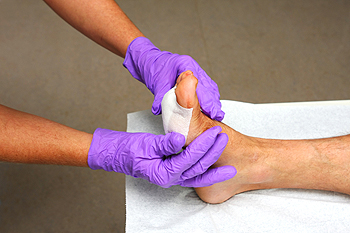
Diabetic foot ulcers are serious complications of diabetes, occurring due to poor circulation, nerve damage, and reduced immune function. High blood sugar levels can impair blood flow and sensation in the feet, leading to delayed wound healing and increased vulnerability to infections. Left untreated, diabetic foot ulcers can result in severe complications, including tissue damage, gangrene, and even limb amputation. Non-invasive treatment typically involves wound debridement, dressings, offloading pressure, and antibiotic therapy to promote healing and prevent infections. More invasive interventions may include surgical debridement, skin grafts, or in severe cases, amputation. If you have diabetes, it is strongly suggested that you schedule an appointment with a podiatrist for a comprehensive assessment, wound care, and education on preventive measures tailored to your specific situation.
Wound care is an important part in dealing with diabetes. If you have diabetes and a foot wound or would like more information about wound care for diabetics, consult with Gregory Rorick, DPM from Rorick Podiatry, PC. Our doctor will assess your condition and provide you with quality foot and ankle treatment.
What Is Wound Care?
Wound care is the practice of taking proper care of a wound. This can range from the smallest to the largest of wounds. While everyone can benefit from proper wound care, it is much more important for diabetics. Diabetics often suffer from poor blood circulation which causes wounds to heal much slower than they would in a non-diabetic.
What Is the Importance of Wound Care?
While it may not seem apparent with small ulcers on the foot, for diabetics, any size ulcer can become infected. Diabetics often also suffer from neuropathy, or nerve loss. This means they might not even feel when they have an ulcer on their foot. If the wound becomes severely infected, amputation may be necessary. Therefore, it is of the upmost importance to properly care for any and all foot wounds.
How to Care for Wounds
The best way to care for foot wounds is to prevent them. For diabetics, this means daily inspections of the feet for any signs of abnormalities or ulcers. It is also recommended to see a podiatrist several times a year for a foot inspection. If you do have an ulcer, run the wound under water to clear dirt from the wound; then apply antibiotic ointment to the wound and cover with a bandage. Bandages should be changed daily and keeping pressure off the wound is smart. It is advised to see a podiatrist, who can keep an eye on it.
If you have any questions, please feel free to contact our office located in New York Mills, Utica, NY . We offer the newest diagnostic and treatment technologies for all your foot care needs.
The Definition of Tarsal Tunnel Syndrome
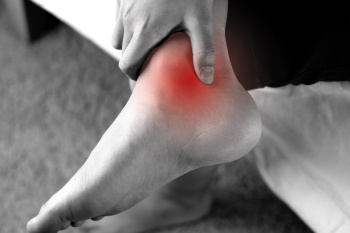
Tarsal tunnel syndrome is a relatively lesser-known condition compared to other nerve-related disorders, yet it can cause significant discomfort and affect daily life. This syndrome occurs when the tibial nerve, which runs along the inside of the ankle, becomes compressed or squeezed as it passes through the tarsal tunnel, which is a narrow space formed by bone and ligaments on the inner side of the ankle. One important fact about tarsal tunnel syndrome is that it shares similarities with carpal tunnel syndrome, a condition affecting the wrist. Individuals with tarsal tunnel syndrome may experience symptoms such as numbness, tingling, burning pain, or electric shock-like sensations in the ankle, heel, and sole of the foot. Various factors, including injury, inflammation, flat feet, or systemic conditions like diabetes, can contribute to the development of this syndrome. If you are experiencing pain in this part of your foot, it is suggested that you visit a podiatrist who can diagnose and treat tarsal tunnel syndrome.
Tarsal tunnel syndrome can be very uncomfortable to live with. If you are experiencing tarsal tunnel syndrome, contact Gregory Rorick, DPM of Rorick Podiatry, PC. Our doctor can provide the care you need to keep you pain-free and on your feet.
Tarsal Tunnel Syndrome
Tarsal tunnel syndrome, which can also be called tibial nerve dysfunction, is an uncommon condition of misfiring peripheral nerves in the foot. The tibial nerve is the peripheral nerve in the leg responsible for sensation and movement of the foot and calf muscles. In tarsal tunnel syndrome, the tibial nerve is damaged, causing problems with movement and feeling in the foot of the affected leg.
Common Cause of Tarsal Tunnel Syndrome
- Involves pressure or an injury, direct pressure on the tibial nerve for an extended period of time, sometimes caused by other body structures close by or near the knee.
- Diseases that damage nerves, including diabetes, may cause tarsal tunnel syndrome.
- At times, tarsal tunnel syndrome can appear without an obvious cause in some cases.
The Effects of Tarsal Tunnel Syndrome
- Different sensations, an afflicted person may experience pain, tingling, burning or other unusual sensations in the foot of the affected leg.
- The foot muscles, toes and ankle become weaker, and curling your toes or flexing your foot can become difficult.
- If condition worsens, infections and ulcers may develop on the foot that is experiencing the syndrome.
A physical exam of the leg can help identify the presence of tarsal tunnel syndrome. Medical tests, such as a nerve biopsy, are also used to diagnose the condition. Patients may receive physical therapy and prescriptive medication. In extreme cases, some may require surgery.
If you have any questions please feel free to contact our office located in New York Mills, Utica, NY . We offer the newest diagnostic and treatment technologies for all your foot and ankle needs.
Ingrown Toenails and Why They Occur
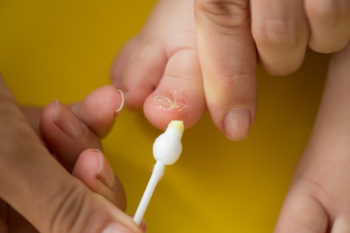
Ingrown toenails occur when the edge of a toenail grows into the surrounding skin, leading to pain, swelling, and redness. This condition typically affects the big toe and can result from various factors, such as improper trimming, wearing tight-fitting shoes, injury, or genetic predisposition. Symptoms include tenderness along the nail border, inflammation, and sometimes infection, which may result in pus or drainage. People with curved or thickened nails, athletes, individuals with poor foot hygiene, or those with certain medical conditions like diabetes are more susceptible to ingrown toenails. Treatment from a podiatrist often involves gently lifting the ingrown edge, trimming the nail properly, and providing guidance on proper nail care techniques. In some cases, a portion of the nail may need to be removed to prevent recurrence. For severe or recurrent ingrown toenails, surgical procedures like partial nail avulsion may be recommended by a podiatrist to alleviate pain and prevent complications. If you have an ingrown toenail, it is suggested that you schedule an appointment with a podiatrist for treatment that is best for your condition.
Ingrown toenails may initially present themselves as a minor discomfort, but they may progress into an infection in the skin without proper treatment. For more information about ingrown toenails, contact Gregory Rorick, DPM of Rorick Podiatry, PC. Our doctor can provide the care you need to keep you pain-free and on your feet.
Ingrown Toenails
Ingrown toenails are caused when the corner or side of a toenail grows into the soft flesh surrounding it. They often result in redness, swelling, pain, and in some cases, infection. This condition typically affects the big toe and may recur if it is not treated properly.
Causes
- Improper toenail trimming
- Genetics
- Improper shoe fitting
- Injury from pedicures or nail picking
- Abnormal gait
- Poor hygiene
You are more likely to develop an ingrown toenail if you are obese, have diabetes, arthritis, or have any fungal infection in your nails. Additionally, people who have foot or toe deformities are at a higher risk of developing an ingrown toenail.
Symptoms
Some symptoms of ingrown toenails are redness, swelling, and pain. In rare cases, there may be a yellowish drainage coming from the nail.
Treatment
Ignoring an ingrown toenail can have serious complications. Infections of the nail border can progress to a deeper soft-tissue infection, which can then turn into a bone infection. You should always speak with your podiatrist if you suspect you have an ingrown toenail, especially if you have diabetes or poor circulation.
If you have any questions, please feel free to contact our office located in New York Mills, Utica, NY . We offer the newest diagnostic and treatment technologies for all your foot care needs.
Various Types of Heel Pain Symptoms
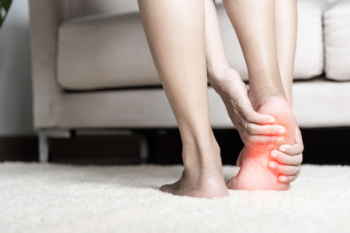
Heel pain can manifest in several forms, each indicating distinct underlying causes and contributing factors. Side heel pain, also known as lateral heel pain, typically occurs on the outer edge of the heel and may stem from conditions like Achilles tendonitis or Haglund's deformity, where a bony prominence irritates the surrounding tissue. Inside heel pain often arises from conditions like plantar fasciitis or heel spurs, which involve inflammation and irritation of the tissues on the underside of the foot near the heel. Additionally, individuals may experience right or left heel pain, which could result from biomechanical issues, uneven weight distribution, or asymmetrical gait patterns. Identifying the specific location and characteristics of heel pain is essential for accurate diagnosis and effective treatment. If you have any type of heel pain, it is suggested that you consult a podiatrist who can provide you with a tailored treatment plan.
Many people suffer from bouts of heel pain. For more information, contact Gregory Rorick, DPM of Rorick Podiatry, PC. Our doctor can provide the care you need to keep you pain-free and on your feet.
Causes of Heel Pain
Heel pain is often associated with plantar fasciitis. The plantar fascia is a band of tissues that extends along the bottom of the foot. A rip or tear in this ligament can cause inflammation of the tissue.
Achilles tendonitis is another cause of heel pain. Inflammation of the Achilles tendon will cause pain from fractures and muscle tearing. Lack of flexibility is also another symptom.
Heel spurs are another cause of pain. When the tissues of the plantar fascia undergo a great deal of stress, it can lead to ligament separation from the heel bone, causing heel spurs.
Why Might Heel Pain Occur?
- Wearing ill-fitting shoes
- Wearing non-supportive shoes
- Weight change
- Excessive running
Treatments
Heel pain should be treated as soon as possible for immediate results. Keeping your feet in a stress-free environment will help. If you suffer from Achilles tendonitis or plantar fasciitis, applying ice will reduce the swelling. Stretching before an exercise like running will help the muscles. Using all these tips will help make heel pain a condition of the past.
If you have any questions please contact our office located in New York Mills, Utica, NY . We offer the newest diagnostic and treatment technologies for all your foot and ankle needs.
Heel Pain Can Be Treated!
High Ankle Sprains From Playing Volleyball
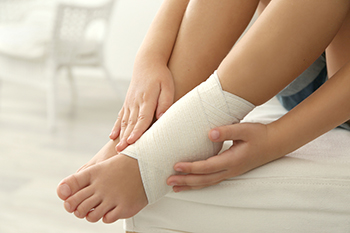
Recovery from a high ankle sprain sustained while playing volleyball requires patience and proper care. Unlike a low ankle sprain, which affects the ligaments on the outer side of the ankle, a high ankle sprain involves damage to the ligaments connecting the tibia and fibula bones above the ankle joint. High ankle sprains often occur due to sudden twisting or rotational movements. If you play volleyball for fun or sport and have injured your ankle, it is suggested that you schedule an appointment with a podiatrist for a comprehensive evaluation of the injury and a tailored treatment plan. This may include immobilization with a brace or cast to allow for proper healing, along with recommendations for rest, compression, and elevation. In severe cases, surgery may be necessary to repair torn ligaments. Close monitoring by a podiatrist ensures that the recovery progresses smoothly and helps prevent long-term complications.
Ankle and foot injuries are common among athletes and in many sports. They can be caused by several problems and may be potentially serious. If you are feeling pain or think you were injured in a sporting event or when exercising, consult with Gregory Rorick, DPM from Rorick Podiatry, PC. Our doctor will assess your condition and provide you with quality foot and ankle treatment.
Common Injuries
The most common injuries that occur in sporting activities include:
- Achilles Tendonitis
- Achilles Tendon Rupture
- Ankle Sprains
- Broken Foot
- Plantar Fasciitis
- Stress Fractures
- Turf Toe
Symptoms
Symptoms vary depending upon the injury and in some cases, there may be no symptoms at all. However, in most cases, some form of symptom is experienced. Pain, aching, burning, bruising, tenderness, tightness or stiffness, sensation loss, difficulty moving, and swelling are the most common symptoms.
Treatment
Just as symptoms vary depending upon the injury, so do treatment options. A common treatment method is known as the RICE method. This method involves rest, applying ice, compression and elevating the afflicted foot or ankle. If the injury appears to be more serious, surgery might be required, such as arthroscopic or reconstructive surgery. Lastly, rehabilitation or therapy might be needed to gain full functionality in the afflicted area. Any discomfort experienced by an athlete must be evaluated by a licensed, reputable medical professional.
If you have any questions, please feel free to contact our office located in New York Mills, Utica, NY . We offer the newest diagnostic and treatment technologies for all your foot care needs.

